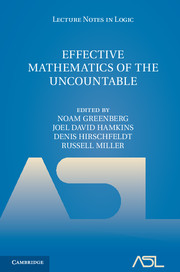Refine search
Actions for selected content:
48243 results in Computer Science
ROB volume 32 issue 1 Cover and Front matter
-
- Article
-
- You have access
- Export citation

Effective Mathematics of the Uncountable
-
- Published online:
- 05 December 2013
- Print publication:
- 31 October 2013
CPC volume 23 issue 1 Cover and Back matter
-
- Journal:
- Combinatorics, Probability and Computing / Volume 23 / Issue 1 / January 2014
- Published online by Cambridge University Press:
- 03 December 2013, pp. b1-b2
-
- Article
-
- You have access
- Export citation
Almost Every Tree With m Edges Decomposes K2m,2m
-
- Journal:
- Combinatorics, Probability and Computing / Volume 23 / Issue 1 / January 2014
- Published online by Cambridge University Press:
- 03 December 2013, pp. 50-65
-
- Article
- Export citation
CPC volume 23 issue 1 Cover and Front matter
-
- Journal:
- Combinatorics, Probability and Computing / Volume 23 / Issue 1 / January 2014
- Published online by Cambridge University Press:
- 03 December 2013, pp. f1-f2
-
- Article
-
- You have access
- Export citation
Conflict-Free Colouring of Graphs
-
- Journal:
- Combinatorics, Probability and Computing / Volume 23 / Issue 3 / May 2014
- Published online by Cambridge University Press:
- 29 November 2013, pp. 434-448
-
- Article
- Export citation
Linear Index Coding via Semidefinite Programming†
-
- Journal:
- Combinatorics, Probability and Computing / Volume 23 / Issue 2 / March 2014
- Published online by Cambridge University Press:
- 29 November 2013, pp. 223-247
-
- Article
- Export citation
Site Percolation on the d-Dimensional Hamming Torus
-
- Journal:
- Combinatorics, Probability and Computing / Volume 23 / Issue 2 / March 2014
- Published online by Cambridge University Press:
- 29 November 2013, pp. 290-315
-
- Article
- Export citation
THE EXPRESSIVITY OF FACTUAL CHANGE IN DYNAMIC EPISTEMIC LOGIC
-
- Journal:
- The Review of Symbolic Logic / Volume 7 / Issue 2 / June 2014
- Published online by Cambridge University Press:
- 28 November 2013, pp. 208-221
- Print publication:
- June 2014
-
- Article
- Export citation
NLE volume 20 issue 1 Cover and Back matter
-
- Journal:
- Natural Language Engineering / Volume 20 / Issue 1 / January 2014
- Published online by Cambridge University Press:
- 28 November 2013, pp. b1-b4
-
- Article
-
- You have access
- Export citation
NLE volume 20 issue 1 Cover and Front matter
-
- Journal:
- Natural Language Engineering / Volume 20 / Issue 1 / January 2014
- Published online by Cambridge University Press:
- 28 November 2013, pp. f1-f2
-
- Article
-
- You have access
- Export citation


